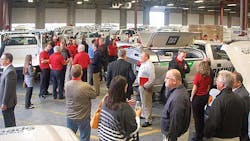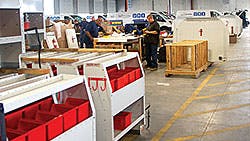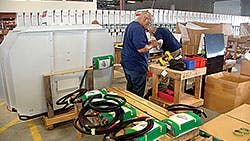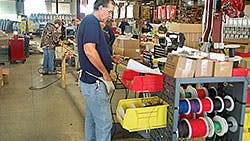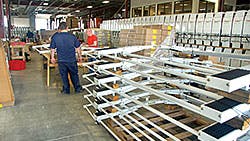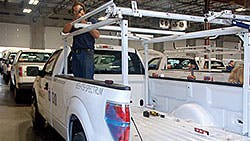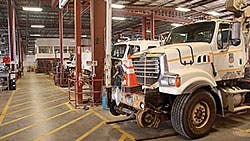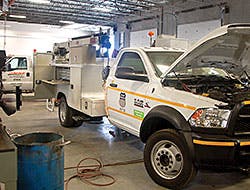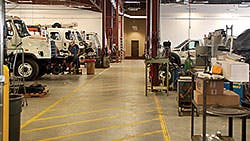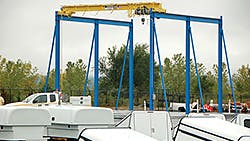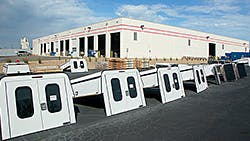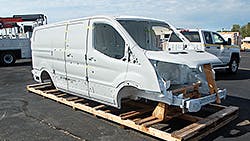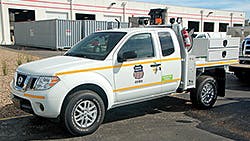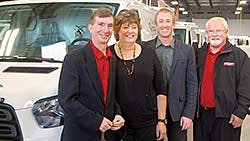Auto Truck Group bets big that Ford’s new van will change truck equipment
WHEN will American truck fleets begin to view European-inspired vans as viable options to the pickups and chassis cabs that have been the backbone of North America’s commercial truck market?
Auto Truck Group is convinced that the process has already begun. Anticipating the change, the company opened a sprawling truck equipment facility close to the plant where Ford is building its new Transit—the popular European van that is taking the place of the venerable Econoline.
The 68,000-sq-ft ship-through facility, located near the recently retooled Ford plantin Kansas City, was built to upfit thousands of Transits each year.
Updated and enlarged at a cost of $1.1 billion, the Ford plant has been manufacturing the Transit since last spring. However, the company also will use the plant to build the new F-150. Ford announced in late February that it is training a wide range of employees as the company prepares to begin production of the new truck by the end of the first quarter. The truck is already in production at the Ford plant in Dearborn, Michigan. Between the two plants, the company expects to produce an estimated 700,000 F-150s annually.
It’s the new van, though, that especially caught the eye of Auto Truck management. It takes a special product to replace a brand that has been around for almost a half century. But that’s what Ford did when it decided to replace the Econoline with the Transit, a van that the company has been producing in Europe since 1965. Ford sells the Transit in 118 markets in six continents.
“We saw Ford getting into vans,” says Pete Dondlinger, vice-president. “We knew this would change the truck equipment business. When Ford announced that they were going to produce the Transit in Kansas City, we immediately began looking for a place to acquire.”
Headquartered in the Chicago suburb of Bartlett, Illinois, Auto Truck already had a location in Kansas City, primarily to upfit the F-150. But as management learned more about Ford’s plans for the Transit, it became clear that the company needed a much larger facility to accommodate the anticipated production from the retooled truck plant.
Auto Truck found property in mid-2013 and took occupancy in late spring last year. Planning and construction went smoothly in large part because the Kansas City shop was patterned after the company’s flagship facility in Bartlett. Auto Truck spent two years planning and building that facility, a 103,000-sq-ft structure located on a 16-acre tract.
“Kansas City eventually will be the largest location that we have,” Dondlinger says. “We know that Ford’s volume is going to get much larger. As their business grows, we are going to grow with them.”
The new location takes the place of two separate shops that Auto Truck had been operating in the Kansas City area, both of which have now been sold. One of the two facilities was home for Fleet Body & Equipment, which is now part of Auto Truck.
The shop is not just a place to put equipment on Ford vehicles. Auto Truck and Fleet Body & Equipment have had a long history serving customers in Kansas City and points beyond, particularly fleets and railroads in addition to general truck equipment.
“We really do have a diverse market here,” Dondlinger says. “We are more than a high-volume ship-through operation. We build a lot of complex trucks. We have a lengthy history doing business in Kansas City, and we opened this facility in order to build on that history.
“Kansas City and Chicago have similar production space. The main difference at this point is the presence of the additional offices we have back in Bartlett.”
The new facility has 65 mechanics, already more than any other Auto Truck location. During a 90-day period in late summer and early fall, the company was able to hire 40 mechanics.
Laying out the shop
The new shop reflects the diversity of the market that Auto Truck serves. A central shop office divides the production area roughly in half. One half, slightly larger than the other, is the ship-through operation. The other half is divided by a center aisle, with general truck equipment on one side and railroad service trucks being processed on the other.
“Most of the facility is for ship-throughs,” Dondlinger says. “It’s designed around big runs, rather than the lower-volume, labor-intensive trucks that we build for other customers.”
Minimum support columns enable the company to configure the production areas in a variety of ways.
The shop does not have any bridge cranes. Instead, a gantry system does the heavy lifting. Forklifts are used to move smaller truck bodies for mounting.
“We find that forklifts can handle most of our needs, and the gantry system can take care of the rest,” Dondlinger says. “Bridge cranes have their place, but they really complicate the specs that the building will have to meet.
The shop contains 68,000 square feet on 17 acres. The operation needs plenty of land in order to accommodate the volume that Auto Truck expects. With Auto Truck fitting approximately 100 F-150 trucks per acre, the site provides plenty of room to store incoming chassis and completed vehicles.
Working ahead
So how does Auto Truck set up a shop for large orders?
One major way is to assemble components ahead of time—particularly the electrical work. The Auto Truck engineering group designs wiring harnesses specifically for the job, and a team assembles them in a dedicated area in the shop.
“This hugely controls our ability to maintain standards and quality,” Dondlinger says. “We utilize the upfitter switches that the chassis manufacturer builds into the truck whenever we can. These multiplexed electrical systems that the chassis manufacturers have developed are a great way to save time and ensure quality. But the more complex jobs require more. In that case, we make our own power distribution centers.”
Auto Truck preassembles wiring harnesses for the jobs at hand. The applications are many—dome lights for van bodies, strobes, and other electrical applications.
All harness are designed and built to make sure the truck continues to meet FMVSS 108 requirements. They also must meet specifications set by Ford’s Modified Vehicle Engineering department.
“All approved Ford ship-though companies are audited annually to make sure we meet their standards,” Dondlinger says.
Power of preassembly
Auto Truck also believes in preassembling other components such as ladder racks, bulkheads, shelving, and other accessories.
“One team preassembles components, and another one installs them in the truck or van,” Dondlinger says. “The whole idea is to be able to get the vehicle to the customer as quickly as possible. That’s our commitment. And one of the best ways to do that is to minimize the amount of time the customer’s truck sits in our bay. Some of the jobs that we perform can be done with only two hours in a bay. Others require 20 hours or more. But either way, we are trying to develop a way to complete the job quickly and accurately and get that vehicle to the customer. These, after all, are trucks the customer uses to make money. They aren’t earning money when they are sitting in our shop.”
The teams that Auto Truck uses can involve multiple people or a single technician—one person wiring, another assembling a ladder rack, and a team doing the installation. The company employs industrial engineers, including one at the Kansas City facility, to study incoming orders and determine how the work can be divided as effectively as possible.
“Some of our orders involve 20,000 man-hours,” Dondlinger says. “So it’s important that we plan out the work ahead of time and perform the work in the time we have budgeted. We need to make our times so that we can get the truck to the customer when we said we would. When we have a well-thought-out plan and we execute it as we should, we don’t have to subsidize inefficiency with overtime or hire otherwise unnecessary personnel.”
One example was the order Auto Truck produced late last year for Charter Communications. The work involved more than 800 light-duty vehicles—primarily the new Ford Transit vans and a smaller number of F-150s.
“It was a very important order for us,” Dondlinger says. “We were familiar with big production runs for pickups and chassis cabs. We were comfortable doing the same work on the same scale with vans.”
Auto Truck has invested heavily to have a state-of-the-art production facility near the newly retooled Ford plant in Kansas City. However, that does not mean that the distributor will not or does not want to work on multiple brands of trucks.
“We want to be able to serve our customers even if they change truck brands,” Dondlinger says. “One of the values we bring is our ability to work on multiple brands of trucks over multiple locations with a single account manager. Single source accountability for complex orders is very important and convenient for fleets.”
Division of labor
Auto Truck employs a variety of classes of technicians in its shop.
“All of our operations are team based,” Dondlinger says. “Some of our jobs require welding; others require complex wiring or hydraulics expertise. Some are simple assembly jobs. But we work on everything from automobiles to complex trucks for fleets. We need people who have special areas of expertise and deep knowledge so that we can take on anything.”
The diversity of the work performed requires a lot of production flexibility. The office area was an existing building, but the shop was built specifically to Auto Truck specifications.
“We think we eventually will be able to get 20,000 vehicles through here per year,” Dondlinger says.
With that level of volume, every task becomes significant. Take, for example, the simple task of checking in a truck.
“When you are small, you can afford to take your time. If it takes an hour to check in a truck, that’s not critical,” says Jenny Skrbina. “But what if you are checking in 100? We could have 1,500 white trucks out there in the yard. Where exactly are they? Who owns them? Suddenly just the simple task of processing this information becomes huge. ”
Auto Truck addresses this problem by using handheld computers to check in trucks as they arrive. The system works much like the ones used at car rental lots to track vehicles as they come and go. Scanned data from the handheld computer automatically is downloaded into the Auto Truck computer management system in order to provide detailed information regarding the status of each vehicle.
Fleet management
Auto Truck is owned by ARI, reportedly the largest privately held fleet management service company in the world. ARI employs more than 2,800 people throughout the world and manages more than a million vehicles in North America and Europe. The number of vehicles exceeds two million when its partnerships elsewhere are considered.
ARI was formed just after World War II. Its parent company, Holman Auto Group, began as a simple dealership in 1924 selling the Ford Model T and Model A
“We started as a desk at Holman Ford,” says Carl Ortel, president of ARI.
Today the company buys about 100,000 vehicles per year, providing maintenance management, accident management, renewal management, open and closed end leasing, vehicle acquisition services, vehicle remarketing, telematics, driver training, safety manuals, and other services.
Recently ARI has been actively acquiring other companies, including four companies in Europe in a 15-month period. Auto Truck joined them in 2010.
“We are consistently building on past successes,” Ortel says. ♦
St. Louis even newer
Auto Truck’s Kansas City shop has only been open since June 2014, but it is not the company’s newest. That distinction goes (at least temporarily) to the company’s work truck and commercial van upfitting and manufacturing facility in the Saint Louis suburb of O’Fallon, Missouri. It opened in December 2014.
This 40,000 square foot facility is enough space to upfit more than 30 vehicles concurrently. The facility also has two acres of storage, and many more features to support the installation of truck equipment for a wide variety of users and applications. It was opened to serve truck fleets in industries such as energy, telecommunications, railroad, municipalities, and construction.
The facility has been awarded ship through for new 2015 Chevy Colorado and GMC Canyon, Chevy Express and GMC Savanna (ship-through code TBQ), and Chevy City Express (ship-though code SQF).
“We are proud to announce this new facility, including the important addition of ship-through for the new GM trucks and commercial vans,” says Jim Dondlinger, president for Auto Truck Group. “Our new facility will serve both regional and national customers and fleets.”
Other locations include Chicago; Colorado Springs and Denver, Colorado; Fort Wayne, Indiana; Fort Worth, Texas; Kansas City, Missouri; Louisville, Kentucky; Maple Shade, New Jersey; and Toronto, Ontario, Canada. ♦About the Author
Bruce Sauer
Editor
Bruce Sauer has been writing about the truck trailer, truck body and truck equipment industries since joining Trailer/Body Builders as an associate editor in 1974. During his career at Trailer/Body Builders, he has served as the magazine's managing editor and executive editor before being named editor of the magazine in 1999. He holds a Bachelor of Journalism degree from the University of Texas at Austin.
